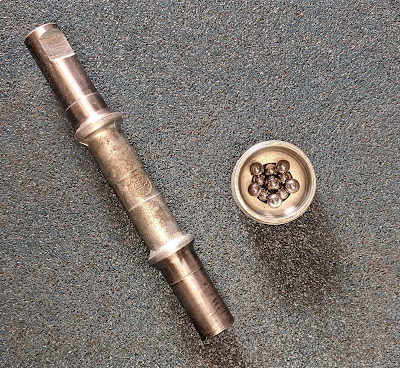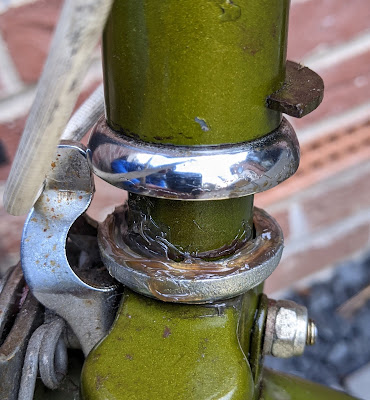Just before Shimano came up with the Hyperglide (HG) cassette system that we know and love today, it introduced the Uniglide (UG) arrangement. It was an 1980s effort to provide not only a cassette system, but also teeth features to improve shifting (especially for the indexing 'click' that is pretty much standard now). I happen to have such a cassette in 6 speed - they were produced in 5, 6, 7 and 8 speed. Generally, UG cassettes are rare these days, while screw-on freewheel types remain relatively abundant. This post is about cleaning and re-jigging my Uniglide cassette, currently 13-14-15-17-19-21T, and my thoughts about it. I want to dismantle, clean and swap out one of the cogs to allow me to put in a bigger 24T. Photo before I started work:
Yes, it's dirty, and the grime is stuck hard! If you've never seen a Uniglide cassette before, then it could be confusing. It has neither Hyperglide's splined lockring nor the spline socket that screw-on freewheel types have. It does have a freehub body, much like the modern Hyperglide, but all the splines are the same width. Instead of the HG lockring, the topmost cog is screwed down on to the upper part of the freehub body, which is partially threaded, to hold everything together. The 24T cog that I want to add is the black one in the photo. To dismantle, you use 2 chain whips to hold the wider cog, while unscrewing the topmost cog (13T):
Thankfully it unscrewed fairly easily. Turned over, you can see the cutouts for weight reduction and the three small bolts that hold the unit together. The top locking cog (13T) has an inbuilt spacer and is threaded on its inside.
The bolts need to come out. The bolts have a smooth shaft and are threaded at their tip. They screw only into the matching threaded holes in the 14T cog:
Taking off the 14T cog, there are identical plastic spacers between the remaining cogs:
I cleaned up the parts and started to refit. In this photo you can see the threading on the upper part of the freehub body. Apparently, it's possible to change that body for a HG one, but why bother when this seems little worn and is functioning beautifully. Also, I think the threading on Dura Ace is different - presumably an attempt to keep it "exclusive" and apart from the mass market! I've placed the new 24T on first, then a plastic spacer:
Looking at the splines on 19T, note the absence of the wider notch and narrower notch. Also note the three holes for the bolts - these are present in everything, spacers, washer and cogs. I'm not going to use the bolts as their main purpose is to hold the cassette together for easy fitting.
In the photo above, you can see two teeth features designed to improve shifting. Firstly, two opposing teeth on the 17T cog are shorter. These provide avenues for the chain to dismount as you shift. Secondly, you can just see the twist of all teeth. These features are the precursor of Hyperglide teeth shaping. Place cog, spacer, cog spacer, etc... until you reach the penultimate one, then the thin washer goes on:
Now you can clearly see the threading on the freehub body to take the last locking cog 13T. Put that last one on carefully by hand, to ensure threads are not crossed! Then tighten it with a chain whip, but it's not really necessary to strain yourself doing that, because the process of pedalling will tighten it. In fact, when I put it into top gear while riding, I felt the slight slip as it tightened into position. Here's a pic of the removed bolts and 14T cog, which I'll be putting away carefully in my bits box. Only some cogs had the shorter opposing teeth pairs:
Now a photo of the bike in which this wheel goes, my Dawes Impulse (see previous posts):
And a closeup of the cleaned cassette newly configured to: 13-15-17-19-21-24T, with the vintage super-cool Shimano 105 mech:
One thing you need to check for is that the chain is long enough to handle cross-chained big-big. Even if you're not supposed to use that gear, it is wise to ensure that the chain is long enough for it to be engaged otherwise you can break things. To my relief, it was long enough.
CHUCK'S TECH OPINION ON UNIGLIDE
I thoroughly enjoyed working on my Uniglide cassette, because the quality of manufacture is superb, and everything disassembles and fits well. It was easy to remove the bolts (using quality pliers). This is better than those annoying rivets in modern cassettes, but I can understand that rivets would be much cheaper than those three bolts when it comes to mass production.
Test riding was magic! It shifted positively, flawlessly, and the indexing was spot on. Definitely the crispest shifting bike with down tube levers that I've ever owned and I'm comparing here to both screw-on freewheels and even more modern 9 speed Hyperglide hubs. (Perhaps that's because the tolerances, both cog-spacing and lever-indexing, for 6 speed are more forgiving compared to the narrower 9 speed?).
Another great advantage is that the uniform spline widths allow you to invert each cog. Useful to maximise working life, as worn cogs may be simply turned around. While I like this and it resonates with today's re-use, up-cycle culture, it is not the ideal situation for the capitalist mass-producer who wants sales (think Apple iPhones and OS upgrades that render one's device slow). I think that is part of the reason why we have modern riveted cassettes and non-reversible cogs today. Also, I suspect that with different width spacers, you may use the same freehub body to build up a 5, 7 or 8 speed cassette, but I haven't tried it and would have to research the standards for that (i.e. spacer widths, cog thicknesses and overall hub body height).
In its time in the 1980s, Uniglide was top-end and a step-forward in smoothness of shifting and ease of indexation. I can appreciate why. Uniglide hubs are ultra-rare nowadays, so the information in this post is really for bike nuts, the sake of history, or those who accidentally come across one. Feel lucky if you do though because from what I've seen, a new old stock Uniglide cassette can sell for £60-£100!






































